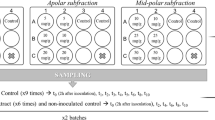Abstract
In this study, the antimicrobial effects of an onion peel extract prepared using subcritical water extraction (SWE) were assessed for possible development into new bio-functional materials. The extraction temperatures were controlled to 110 and 160°C. At 0.15, 0.3, 0.6, and 1.2 mg extract/mL of broth, the growth inhibition and bactericidal activity of SWE extracts against Bacillus cereus KCCM 40935 and KCCM 11341 were compared with those of ethanol and hot-water extracts. In the case of B. cereus KCCM 40935, it appeared that over 0.6 mg/mL of SWE (110°C) extract exerted a bactericidal effect, and 1.2 mg/mL of SWE (160°C) extract exerted a bacteriostatic effect during culturing, and also that B. cereus KCCM 11341 was more resistant than B. cereus KCCM 40935. Furthermore, our results demonstrated that the death time of 107 CFU/mL of B. cereus KCCM 40935 treated with SWE (110°C) extract at 1.2 mg/mL was 60 min at maximum in 0.8% NaCl. Additionally, the cells damaged by SWE extract were observed with a SEM. It was suggested that an extract of onion peels prepared via SWE (110°C) could be used as a functional biomaterial for the food or pharmaceutical industries.
Similar content being viewed by others
References
Lanzotti V. The analysis of onion and garlic. J. Chromatogr. A 1112: 3–22 (2006)
Griffiths G, Trueman L, Crowther T, Thomas B, Smith B. Onions-A global benefit to health. Phytother. Res. 16: 603–615 (2002)
Taran M, Rezaeian M, Izaddoost M. In vitro antitrichomonas activity of Allium hirtifolium (Persian shallot) in comparison with metronidazole. Iran J. Publ. Health 35: 92–94 (2006)
Hertog MG, Feskens EJ, Hollman PC, Katan MB, Kromhout D. Dietary antioxidant flavonoids and risk of coronary heart disease: The Zutphen elderly study. Lancet 342: 1007–1011 (1993)
Coghill D, Juffs HS. Incidence of psychrotrophic sporeforming bacteria in pasteurized milk and cream products and effect of temperature on their growth. Aust. J. Dairy Technol. 34: 150–153 (1979)
Johnston DW, Bruce J. Incidence of thermoduric psychrotrophs in milk produced in the west of Scotland. J. Appl. Bacteriol. 52: 333–337 (1982)
Wong HC, Chang MH, Fan JY. Incidence and characterization of Bacillus cereus isolates contaminating dairy products. Appl. Environ. Microb. 54: 699–702 (1988)
Ahmed AAH, Moustafa MK, Marth EH. Incidence of Bacillus cereus in milk and some milk products. J. Food Protect. 46: 126–128 (1983)
Larsen HD, Jørgensen K. The occurrence of Bacillus cereus in Danish pasteurized milk. Int. J. Food Microbiol. 46: 173–176 (1997)
te Giffel MC, Beumer RR, Granum PE, Rombouts FM. Isolation and characterization of Bacillus cereus from pasteurized milk in household refrigerators in the Netherlands. Int. J. Food Microbiol. 34: 307–318 (1997)
Ramos L, Kristenson EM, Brinkman UAT. Current use of pressurized liquid extraction and subcritical water extraction in environmental analysis. J. Chromatogr. A 975: 3–29 (2002)
Ibanez E, Kubatova A, Senorans FJ, Cavero S, Reglero G, Hawthorne SB. Subcritical water extraction of antioxidant compounds from rosemary plants. J. Agr. Food Chem. 51: 375–382 (2003)
Garcia-Marino M, Rivas-Gonzalo JC, Ibanez E, Garcia-Moreno C. Recovery of catechins and proanthocyanidins from winery byproducts using subcritical water extraction. Anal. Chim. Acta 563: 44–50 (2006)
Kim JW, Mazza G. Optimization of extraction of phenolic compounds from flax shives by pressurized low polarity water. J. Agr. Food Chem. 54: 7575–7584 (2006)
Cacace JE, Mazza G. Pressurized low polarity water extraction of lignans from whole flaxseed. J. Food Eng. 77: 1087–1095 (2006)
Ju ZY, Howard LR. Subcritical water and sulfured water extraction of anthocyanins and other phenolics from dried red grape skin. J Food Sci. 70: 270–2076 (2005)
Choi MPK, Chan KKC, Leung HW. Huie CW. Pressurized liquid extraction of active ingredients (ginsenosides) from medicinal plants using non-ionic surfactant solutions. J. Chromatogr. A 983: 153–162 (2003)
Pineiro Z, Palma M, Barroso CG. Determination of catechins by means of extraction with pressurized liquids. J. Chromatogr. A 1026: 19–23 (2004)
Shotipruk A, Kiatsongserm J, Pavasant P, Goto M, Sasaki M. Pressurized hot water extraction of anthraquinones from the roots of Morinda citrifolia. Biotechnol. Progr. 20: 1872–1875 (2004)
Lamm LJ, Yang Y. Off-line coupling of subcritical water extraction with subcritical water chromatography via a sorbent trap and thermal desorption. Anal. Chem. 75: 2237–2242 (2003)
Viljoen A, Van Vuuren S, Ernst E, Klepser M, Demirci B, Baser H. Osmitopsis astericoides (Asteraceae)-the antimicrobial activity and essential oil composition of a Cape-Dutch remedy. J. Ethnopharmacol. 88: 137–143 (2003)
Morris CE, Monier JE, Jacques MA. Methods for observing microbial biofilms directly on leaf surfaces and recovering them for isolation of culturable microorganisms. Appl. Environ. Microb. 63: 1570–1576 (1997)
Puupponen-Pimia R, Nohynek L, Meier C, Kahkonen M, Heinonen M, Hopia A, Oksman-Caldentey KM. Antimicrobial properties of phenolic compounds from berries. J. Appl. Microbiol. 90: 494–507 (2001)
Gupta N, Porter TD. Garlic and garlic-derived compounds inhibit human squalene monooxygenase. J. Nutr. 131: 1662–1667 (2001)
Tansey MR, Appleton JA. Inhibition of fungal growth by garlic extract. Mycologia 67: 409–413 (1975)
Bakri IM, Douglas CWI. Inhibitory effect of garlic extract on oral bacteria. Arch. Oral Biol. 50: 645–651 (2005)
Ramos FA, Takaishi Y, Shirotori M, Kawaguchi Y, Tsuchiya K, Shibata H. Antibacterial and antioxidant activities of quercetin oxidation products from yellow onion (Allium cepa) skin. J. Agr. Food Chem. 54: 3551–3557 (2006)
Rose P, Whiteman M, Moore PK, Zhu YZ. Bioactive salk(en)yl cysteine sulfoxide metabolites in the genus Allium: The chemistry of potential therapeutic agents. Nat. Prod. Rep. 22: 351–368 (2005)
Pszczola DE. Antimicrobials: Setting up additional hurdles to ensure food safety. Food Technol. -Chicago 56: 99–107 (2002)
Smith RM. Extractions with superheated water. J. Chromatogr. A 975: 31–46 (2002)
Author information
Authors and Affiliations
Corresponding author
Rights and permissions
About this article
Cite this article
Kim, W.J., Lee, K.A., Kim, KT. et al. Antimicrobial effects of onion (Allium cepa L.) peel extracts produced via subcritical water extraction against Bacillus cereus strains as compared with ethanolic and hot water extraction. Food Sci Biotechnol 20, 1101–1106 (2011). https://doi.org/10.1007/s10068-011-0149-8
Received:
Revised:
Accepted:
Published:
Issue Date:
DOI: https://doi.org/10.1007/s10068-011-0149-8




